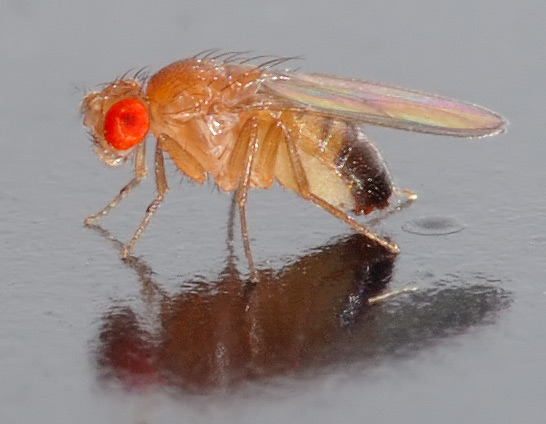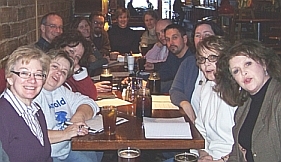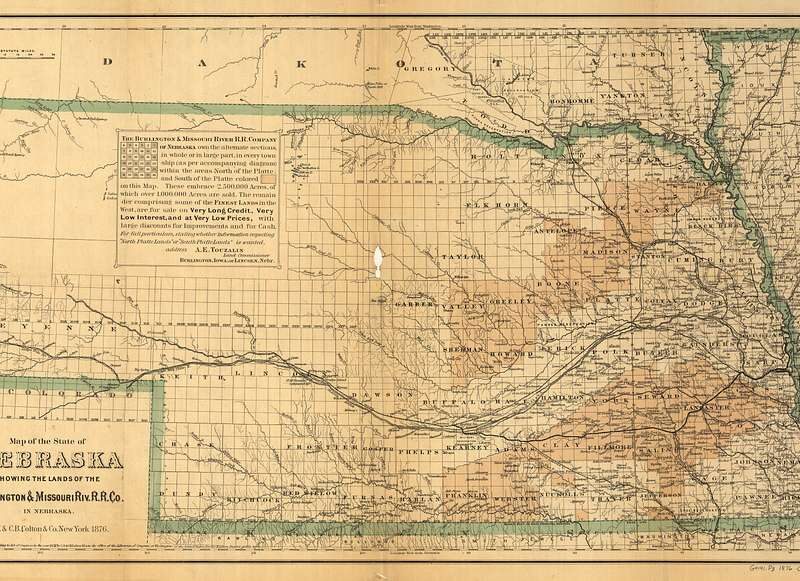A record number of Nebraska Writing Project folk gathered at Misty’s restaurant in downtown Lincoln on an unseasonably warm January 26th. Over lunch, seventeen people introduced themselves as fellow writers and shared marathon destination preferences, then formed writing groups and moved out into the downtown Lincoln art scene. Popular writing settings included the Lentz Center for Asian Culture, the Sheldon Memorial Art Gallery, the Great Plains Art Museum, Kopeli Coffee House, and The Mill. Many writers were particularly inspired by the exhibits “Last Year on the Farm,” at The Great Plains Art Museum and by the “Art Farm @ Sheldon.” At 4:00 p.m. the groups reunited at Yia Yia’s Pizza to share in good cheer, a massive read-around, and insights about writing marathons. Many people recommended more time for writing, voiced enthusiasm for the upcoming Omaha Old Market and Platte River marathons, and suggested we try a rural or small town setting for one of the next marathons.
If you missed this event, don’t despair! Two additional writing marathons are already planned: The Spring Writing Marathon will be held April 12th in Omaha’s Old Market, and the Fall Writing Marathon will be held on September 20th in conjunction with the Platte River Writing Retreat September 19th-21st. Watch for flyers in NeWP mailings and e-newsletters.
Many thanks to the participants, pictured left to right: Chris Lund, Patty Clements, Lisa Fricke, Robert Brooke, Jen Stastny, Daniel Boster, Jane Connealy, Kate Brooke, Sally Burt, Jason McIntosh, Jeff Grinvalds, Tobi Scaggs, Joyce Morrell, and Dee Thompson. Not pictured: Sharon Bishop and Susan Martens-Baker, Rhonda Schoenmaker.
The Platte in January
by Dan Boster
The Mill
Lincoln, Nebraska
1/26/08
Early this morning, driving across the Platte, I believe I came to an understanding of the subtle hope at the root of lies.
***
The flowing of the shallow river has returned as one thin snaking strip between the false banks formed by now weakening ice. I’ve read of the calamitous uproar of raging rivers thawing. This is not one of those rivers. In those stories, chunks of ice cascade into one another, creating dams downstream. Insane stories of men (wearing red and black flannel shirts, bearded, I’m sure) jumping on to these spontaneous twisting jumbles of ice, placing dynamite, and jumping off as the fuse disappears, the air suddenly all crystal and roar. These scenes are nature’s way of alerting all of our senses to the end of winter, the onset of change. The tellers of this story love the symbolism, the anarchic drama of it all. The listener wants this, too.
***
But, here, the river tells another story—a muted tale. Instead of the rush of sudden thaw, ice coming from the mountain tops, our rivers ice leaves politely. Freeing the deepest part first. Coyly loosing twigs, a beer bottle thrown in last summer. And, on a day like today, one of the false starts in the coming of spring, the ice starts to relinquish just a bit—quietly, orderly.
***
This river is more to our liking here. There will be no adventure, no dynamite. Like the tellers of dynamite, I see the slowly thawing river as our story. A note of goodbye stuck under a coffee mug on the counter, fingers rising in greeting from the steering wheel, tight-lipped smile. This is what most of us are. Our stories may flow, catch things on the way, but go quietly.
At the Great Plains Art Museum for the exhibit “Last Year on the Farm”
by Kate Brooke
Today I want to write about my parents and the “last year on the
farm,” their farm being their home of almost forty years which they
moved out of almost on the eve of its hundredth birthday. So far I
feel mostly okay about it, very grown up and accepting of what
clearly was an overdue change. Come Friday, however, I will visit
them for the first time at their Not My Childhood Home. I wonder how
I will feel when I get there.
Look ahead to Springtime in Nebraska, to when bulbs I planted two or
more years ago come up, or don’t, or appear and are not the colors I
remember choosing from the bins, or whose colors have reverted to an
earlier, core hue. The daffodils always seem to multiply and retain
— if not intensify – their brightness. Jane (my mother) has told me
the natural light is good in their rental home. I think of various
objects, the brass candlestick holder with three pigeons at its base,
the blue glass salt cellar in its silver cherub stand, Jane’s
collection of cooking oils and vinegars and wines now in a corner
cupboard with hinges recently repaired. How will their hues have
changed when I see them in a few days? How will the natural light
illuminate my mother in this new home, this not yet familiar Spring?
Remnants
by Patty Clements
There is a strange, no, eerie sensation in the pit of my stomach. This unique art exhibit of battered old shelves filled with nails, bolts, clamps, bottles, and old wooden crates, awakens something long forgotten in me.
As a young girl I spent almost every weekend and summer vacation on various family farms. I whiled away many hours in barns, corncribs, and sheds playing with my cousins, milking cows, and helping Uncle Lavon do odd jobs around the farm.
The dirt, dust, and rust resurrect sensory images that reside deep in the recesses of my memory. Farm buildings always had a certain rusty dusty odor about them. I’m transported back in time to a rickety shed on my grandparents’ farmstead.
I visited there a few years ago with my husband and some friends. We explored the farmyard and buildings examining remnants from the past. We came across rusty old tools, cracked leather harnesses, and broken pieces of machinery. Terry, who collected antiques, was able to tell us bits and pieces of information about many of the antique farming implements we found scattered around the barnyard.
Eventually we found ourselves standing outside a weathered, white-turned-gray shed. The door on the wobbly old shed creaked as it opened. I remember hoping a strong gust of wind wouldn’t come along and blow the shed over with us inside. It seemed like a distinct possibility!
Inside there was a potpourri of household items and tools. We pawed through the rusty relics and deliberated their possible purposes. Eventually I discovered two beautiful antique white doorknobs attached to rusty metal plates. We speculated about their origin on the homestead and concluded that they came from my grandparents’ home, long since torn down. In my mind’s eye, I saw my dad’s hand reach out and turn a white doorknob to go out the door. The pearl white doorknobs suddenly became treasured trophies to me, as my father died when I was but 3 months old. Those same doorknobs now reside on my shelf, until the day comes when I create a new purpose for them.
A beautiful memory slowly returns to the recesses of my mind. Once again I am standing in a museum looking at the innards of an old red barn; amazed at their power to evoke such vivid memories and place them into this moment in time.
Author’s Note: This is the final draft (?) of a piece I’ve been working on since the Writing Marathon. I’ve been fortunate enough to have two other writers be a part of my circle to help me glean my story. It started because of my intrigue with an art exhibit. Writing about my reaction has been an adventure that brought back many memories from my youth. My goal was to use descriptive language and alliteration to create concrete images to help my readers “see” my story.
Wintry Allegory
by Lisa Fricke
Majestic tree…
Sculpted linear signs of ages past.
Pine scented laurels of green,
bow down to the skirted swirls of snow
insolating the slumbering lifelines until spring.
Gently, a neighboring ice-cold philandering stream
seduces stray branches that lie too close to resist her charms.
Listen to the watery meandering path speak of long ago
acquaintances, now peacefully mingling with mother Earth.
Soft winds whisper ancient stories back to those who dare to listen.
The Robin’s egg blue sky, lures the towering trees to
proudly proclaim the marriage of heaven and Earth.
Sexual Selection and Education
Morrill Hall in the Evolution Display
by Jeff Grinvalds

So this Drosophila walks up to this female and says, “Hey baby, what’s going on?” Actually it’s quite a bit simpler than that. He corners her and makes no bones about announcing his intent to mate with her. He desperately follows her with raised absomen and wings spread wide–wild red eyes gawking, as much as a fly can gawk…
She tries to get away, moving sideways and back. He dances with her–continually advancing toward her. “Come on baby!”
Reflecting on my own selection… my own natural selection, wondering if Darwin ever considered desperation as our catalyst for evolution? The strong may survive, but it’s the desperate who thrive. That fly, that desperate drosophila, unwilling to give up on his mate out of shear fear of failure. The desperate masses who cling to the hope that maybe there is someone there… maybe she will call… maybe she’ll change her mind.
“Sure, she’s walking away now. But I saw the way she looked at me just before she flew off… she’ll be back… I hope.”
Man can be as strong as he wants to be, but let’s face it–it’s persistence that win out over all.
And in my desperation what have I found? In her desperation what has she given up? Our mutual desperation and hope have brought us together–dancing like drosophila–neither strong nor selected, but leaned upon… hoped for… wished into existence through quiet prayers spoken into the pillow at midnight.
From Susan Martens-Baker’s marathon notebook:
2:25 p.m. “Walking Houses” at the Sheldon
Blessed are we who sit amid art, writing and breathing. Blessed respite, new free space in my mind, room to think, room to roam, my brain floating free inside my skull…
This is “Walking Houses,” cool and creepy, the way I like art. They recall the alien invaders of War of the Worlds. Walking Houses invading the landscape. I would love to see these twenty times their current size, out on a field somewhere, hulking giants of postmodern angst… unsettling, insect-like, ready to scuttle across the ragged seas of loneliness.
and sunsets
by Dee Thompson
…and Sunsets
Are those George’s? Lundeen’s or no—
The bronzed pioneer and Native American
That a past curator deemed vital to the
Entrance of the Great Plains Museum
Were now masked by winter grass
Apparently a priority to the new curators…
So much for the Art hiding behind the
Unkempt, unsculptured grass
And inside on the last day of the
Last Day on the Farm Exhibit
The acrylic and oil of a 10-member
Family of geese on their return flight
To NE in spring—
Would that be a last glimpse of what was?
Where were the geese this year? So few
Against the burnt orange/magenta horizon
This fall when once they were so thick
They blocked out the sinking sun for a bit
Has their ebb and flow been challenged
By changing winds as well?
The horizon has not changed.
Fuschia folds into smoky lavender, then
Mesquite blue—a constant backdrop for
Mothers calling children in from the fields
Now text-messaging them to come home
From weary wandering and the
Long, low whistle of a train signals from
Agricultural to Industrial to an
Upside-down Post-Modern deep purple
Blanketed by a burnt orange horizon…
What’s up is down
A DNA spiral spinning new breeds
Of winter grass, geese, children…
and sunsets



